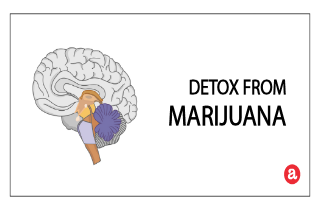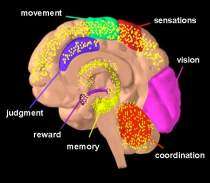ARTICLE OVERVIEW: Many people seem to think marijuana is different from other drugs. This is not the case: you can get addicted to marijuana and may need to go through detox. This article describes what this process can be like and how cases of withdrawal are treated. Then, we invite your questions at the end.
ESTIMATED READING TIME: 5-10 minutes.
TABLE OF CONTENTS:
- Chemistry
- Body and Brain Effects
- Long-Term Effects
- What Detox is Really Like
- Headaches and Depression
- Medications
- Duration
- Can You Detox at Home?
- Inpatient Detox
- Your Questions
As a rule of thumb, acute detox from marijuana can take from a few days to a few weeks, with some symptoms lasting longer.
Chemistry
Marijuana, or cannabis, is the most commonly used illegal drug in the United States of America. It is a psychotropic substance with widespread recreational use worldwide, surpassed only by nicotine and alcohol. It is made from the dried flowers and leaves of a plant called Cannabis Sativa. It is usually smoked in hand-rolled cigarettes called joints or in water pipes called bongs. Sometimes, it is mixed with food, such as cakes and cookies, and eaten.
The cannabis plant contains > 420 chemical compounds, of which 61 are cannabinoids themselves that bind to cannabinoid 1 and 2 (CB1, CB2) receptors in the central nervous system. The neural communication network that uses these cannabinoid neurotransmitters, known as the endocannabinoid system, plays a critical role in the nervous system’s normal functioning, so interfering with it can have profound effects.
This NIDA for Teens diagram outlines exactly how and where marijuana works in the brain:
While experts are still investigating how marijuana works, it is assumed that THC (tetra hydrocannabinol) is the chemical in cannabis, which makes you feel high. This means you experience a change in mood and may see or feel things in a different way. Some parts of the plant contain a higher level of THC. For example, the flowers or buds have more THC than the stems or leaves.
Brain and Body Effects
When you smoke marijuana, THC goes quickly into the blood through the lungs. It then goes to the brain and this is when the high is felt. This can happen within a few minutes and can last up to five hours from each time the smoke is inhaled. However, THC is absorbed quickly into body fat. It is then released very slowly back into the blood. It can take up to one month for a single dose of THC to fully leave the body.
When cannabis is eaten, THC is absorbed more slowly into the blood, as it has to pass through the stomach and intestine. Not only does it take longer to experience the high when the drug is used in this way, the effects can also last for much longer, particularly those that are regarded as unpleasant by the user, such as hallucinogenic effects.
It’s also important to know that regular cannabis use is associated with abnormalities within brain regions with a high density of CB1 receptors, particularly the hippocampus and prefrontal cortex; this is why many people experience a pleasant euphoria and sense of relaxation. Other common effects, which may vary dramatically among different people, include:
- altered perception of time
- heightened sensory perception
- increased appetite
- laughter
Pleasant experiences with marijuana are by no means universal. Instead of relaxation and euphoria, some people experience anxiety, fear, distrust, or panic. These effects are more common when a person takes too much, the marijuana has an unexpectedly high potency, or the person is inexperienced.
People who have taken large doses of marijuana may experience an acute psychosis, which includes hallucinations, delusions, and a loss of the sense of personal identity.
These unpleasant but temporary reactions are distinct from longer-lasting psychotic disorders, such as schizophrenia, that may be associated with the use of marijuana in predisposed people to generate this kind of mental disorders.
Long-Term Effects
Imaging studies of marijuana’s impact on brain structure in humans have shown conflicting results. Some studies suggest regular marijuana use in adolescence is associated with altered connectivity and reduced volume of specific brain regions involved in a broad range of executive functions such as memory, learning, and impulse control compared to people who do not use. Other studies have not found significant structural differences between the brains of people who do and do not use the drug.
What Detox Is Really Like
If you have been taking cannabis for a long period of time, you may find it difficult to stop. Some people can stop using cannabis in one day while others prefer to stop slowly by taking less each time. The way you choose to stop is a personal one but there is assistance available.
People that have gone through withdrawal have reported some of the following signs and symptoms:
- Cannabis craving
- Decreased appetite sweating
- Depressed mood
- Headaches
- Increased aggression
- Increased anger
- Irritability
- Nausea
- Nervousness/anxiety
- Restlessness
- Shakiness/tremulousness
- Sleep difficulty
- Stomach pains
- Strange/wild dreams
Headaches and Depression
Headaches are reported by 16 to 32 % of people who go through detox from weed. While no specific medication is mentioned to treat it, you might consider taking paracetamol or another non-steroidal anti-inflammatory after checking with a prescribing physician.
As for depression, look into the short term prescription of antidepressants for 3-6 months during and after detox. Additionally, preclinical studies are showing that a chemical called URB597 produced analgesic, anxiolytic-like, and antidepressant-like effects in rodents, and has not shown increases in marijuana abuse during dosing.
This evidence suggests that new medicines can begin to make cannabis withdrawal less uncomfortable.
No medications are currently approved to treat cannabis dependence during detox.
Medications
Because symptoms of cannabis withdrawal may lead to relapse, pharmacological treatment aimed making symptoms more manageable can help. However, no medication has regulatory approval for the treatment of cannabis withdrawal.
Several studies have tested the effects of medications on cannabis withdrawal. These medications are either:
1. cannabinoid binding receptor agonists that directly suppress the withdrawal syndrome (analogous to using an opiate to suppress heroin withdrawal), or are
2. designed to indirectly alleviate symptoms of cannabis withdrawal (dysphoric mood, irritability) by influencing the brain circuits that mediate these symptoms.
For example, controlled clinical trials of oral THC are currently underway. So far, the only medication successful in suppression of withdrawal symptoms in the laboratory was a single dose of 10mg/day oral synthetic THC (dronabinol). While this medicine showed potential benefit, questions arise from the use of this medication in cannabis-abusing populations: is it really helpful, or not?
There are some medications NOT IN USE that should be AVOIDED. Experimental findings are not completely consistent, but suggests that clinically used doses of naltrexone are not effective as treatment for cannabis dependence, and might actually increase the abuse liability of cannabis. A recent placebo-controlled study in 29 heavy cannabis smokers found that opioid-receptor blockade by naltrexone (12, 25, 50, or 100 mg daily) enhanced the subjective and cardiovascular effects of cannabis.
Duration
In many cases, the detoxification period for marijuana extends for 30 days, or longer, which corresponds to the amount of time required for marijuana metabolites to be eliminated from the system. However, duration is different for everyone. The amount of time you spend in detox is related to:
- The amount, strength, and frequency of weed you used.
- How long you’ve been using.
- Individual metabolism.
- Your age, gender, weight, and general health.
Duration is also related to the severity of a possible “Cannabis Use Disorder”, or addiction. As a rule of thumb, an “acute” inpatient detoxification treatment lasts between a few days and up to 3 weeks.
Can Detox at Home?
Yes, you can possibly detox from marijuana on your own.
However, you might be sabotaged by cravings, depression, or insomnia. This is why it’s important to seek medical help anytime you want to quit. In fact, cannabis detoxification treatment is usually performed in outpatient settings. However, in these cases, inpatient treatment may be required:
- moderate or severe dependence syndrome
- self-isolation
- moderate or severe psychiatric comorbidity
Inpatient Detox?
So, do you need an inpatient detox clinic to quit?
It really depends on your situation.
In comparison with outpatient programs or trying to quit using weed on your own, inpatient detox can provide you with supportive conditions to quit. You’re monitored medically and have 24-7 support. Plus, experts can evaluate you thoroughly for underlying issues like depression and anxiety. Finally, you can find emotional and psychological support through an inpatient detox.
Your Questions
Do you have any more questions about the process of withdrawal?
You are not alone. Ask us anything else you´ll like to know about this topic. We try to respond to all real-life questions with a personal and prompt reply.










Related Posts